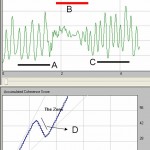Biofeedback as brain training

Biofeedback hardware devices measure and graphically display various physiological variables such as skin conductivity and heart rate variability, so that users can learn to self-adjust. It has been used for decades in medicine. Recently, this technology has emerged in reasonably-priced applications for consumers who want to learn how to manage stress better.
Neurofeedback is a subset of biofeedback relying specifically on electrophysiological measures of brain activity. Using Electroencephalography (EEG) biofeedback to measure brain waves gives the user feedback on different “mental states†like alertness. Neurofeedback is still a tool mostly useful in research and highly specialized clinical contexts, not for mainstream healthcare and/or consumer applications, so we do not cover it in this guide.
Dr. Steenbarger, whose interview can be found at the end of the present chapter, recommends the use of relaxation coupled with biofeedback programs to improve trader’s performance. These programs provide real-time visual feedback on a “trader’s internal performanceâ€. You may be wondering how this may help a trader improve his or her performance? It is because of the close relationship between emotion and cognition. Emotion strongly affects cognition. Stress, as we mentioned earlier, can be very detrimental to performance. Thus, in jobs that are very emotional like trading, it is very important to learn how to self-regulate emotionally in order to improve one’s cognitive performance According to Dr. Steenbarger, biofeedback programs can tell the traders whether they are in optimal conditions to learn and perform or whether they are becoming too stressed.
Keep learning by reading more articles in the Resources section, and also please consider joining our free monthly Brain Fitness eNewsletter”
This new online resource is based on the content from the book The SharpBrains Guide to Brain Fitness (May 2009, $19.95), by Alvaro Fernandez and Dr. Elkhonon Goldberg.
